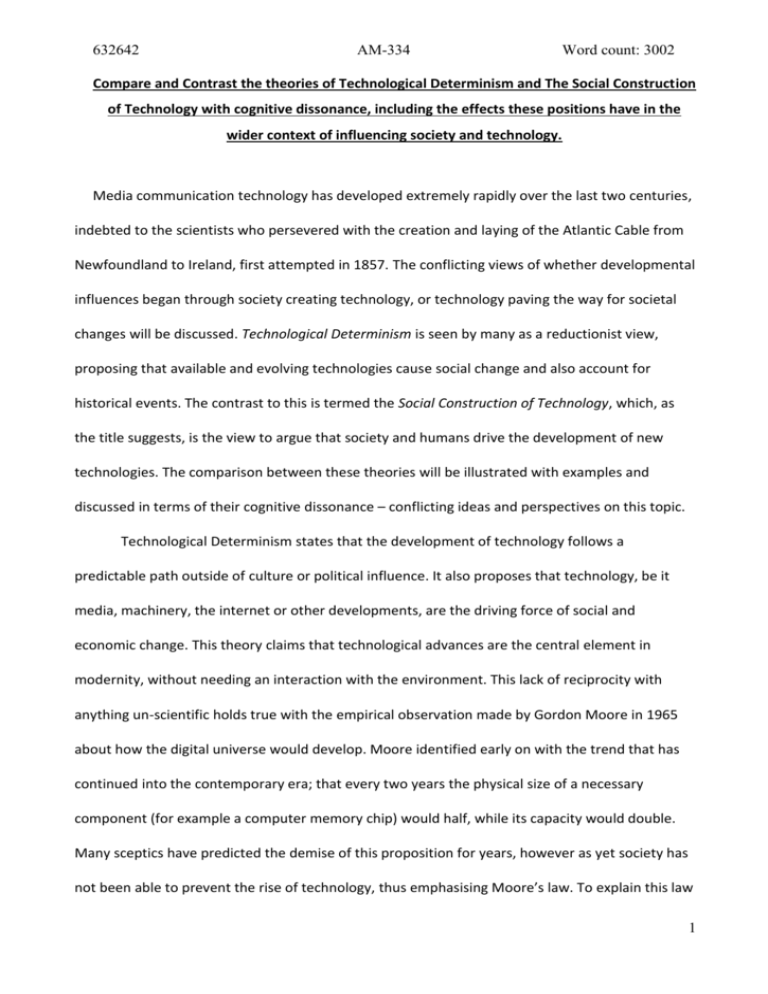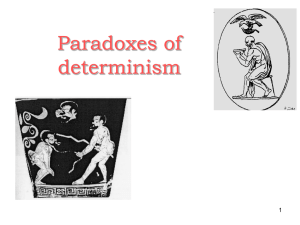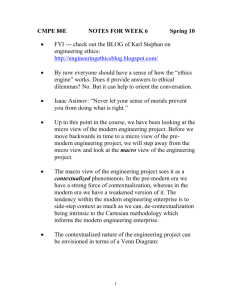Compare and Contrast the theories of Technological Determinism
advertisement

632642 AM-334 Word count: 3002 Compare and Contrast the theories of Technological Determinism and The Social Construction of Technology with cognitive dissonance, including the effects these positions have in the wider context of influencing society and technology. Media communication technology has developed extremely rapidly over the last two centuries, indebted to the scientists who persevered with the creation and laying of the Atlantic Cable from Newfoundland to Ireland, first attempted in 1857. The conflicting views of whether developmental influences began through society creating technology, or technology paving the way for societal changes will be discussed. Technological Determinism is seen by many as a reductionist view, proposing that available and evolving technologies cause social change and also account for historical events. The contrast to this is termed the Social Construction of Technology, which, as the title suggests, is the view to argue that society and humans drive the development of new technologies. The comparison between these theories will be illustrated with examples and discussed in terms of their cognitive dissonance – conflicting ideas and perspectives on this topic. Technological Determinism states that the development of technology follows a predictable path outside of culture or political influence. It also proposes that technology, be it media, machinery, the internet or other developments, are the driving force of social and economic change. This theory claims that technological advances are the central element in modernity, without needing an interaction with the environment. This lack of reciprocity with anything un-scientific holds true with the empirical observation made by Gordon Moore in 1965 about how the digital universe would develop. Moore identified early on with the trend that has continued into the contemporary era; that every two years the physical size of a necessary component (for example a computer memory chip) would half, while its capacity would double. Many sceptics have predicted the demise of this proposition for years, however as yet society has not been able to prevent the rise of technology, thus emphasising Moore’s law. To explain this law 1 632642 AM-334 Word count: 3002 further the Intel Corporation states that; “Transistor density on integrated circuits doubles about every two years.” (1965) or in other words; “The size of each transistor on an integrated circuit chip will be reduced by 50 percent every twenty-four months.” (Kurzweil: 1999) Determinism is largely assumed to be the view that free will cannot exist alongside it, however compatibilist believers in soft determinism see it as a guiding but not entirely omnipotent force in society. Therefore, while technology largely controls our evolution, it is perhaps not the only explanation. As William Fielding Ogburn (1922) pointed out on determinism, despite technology being the leading force, society can still adjust to the consequences of major inventions even if this only occurs after a period of cultural lag. An early example of soft determinism is demonstrated through the Luddites, a group of labourers revolting against the use of new machinery that began replacing their employment. These rebels began their campaign in 1811 as a major part of the Industrial Revolution. Charles A. Beard was a progressive historian who presented a determinist image defining the concern of the Luddites, that; “Technology marches in seven-league boots from one ruthless, revolutionary conquest to another, tearing down old factories and industries, flinging up new processes with terrifying rapidity.” (1927). Hard determinism is seen without the openness of soft determinism’s collaboration with society, although still with the capacity to effect significant change. Ever increasing uses of technology are assumed by many to elicit positive changes in society, however, following experience, this has not always been found to be so. Unfortunately our dependence on technology in the twenty-first century often causes problems in everyday life. Technological Determinism however does not account for human learning and error, as some view the adoption of technology by society as ‘raising more problems than it solves.’ (Ellul). The decision to ban the use of mobile phones while driving in the UK and USA for example, has only occurred as a result of several fatal vehicle crashes, while in many US states it is still legal. Leading twentieth-century philosopher 2 632642 AM-334 Word count: 3002 Jacques Ellul realised in this vain that each innovation creates; “pernicious effects that are inseparable from favourable effects.” (1964). For example the very contemporary problem of not being able to ‘switch off’, be it from work, family, the media etc. Journalist Thomas Friedman spent 4 days in the Amazon jungle in 2006. He described it as a liberating experience away from modern life and realised that in the contemporary era one only ever has “continuous partial attention” to the outside world. Neil Postman wrote in his book - Technopoly: the surrender of culture to technology (1992) about the alarming rate at which individual’s, especially in the USA, are adopting technology without considering its ill-effects. Postman expanded on Ellul’s critique that technology was being ‘deified’ or awarded a god-like status by many without any forethought. Postman defines Technopoly as: “a state of culture (and) a state of mind. It consists in the deification of technology, which means that the culture seeks its authorization in technology, finds it satisfactions in technology, and takes its orders from technology.” (p. 33) It cannot be said that technology has not significantly enhanced the modern world with a view to medical, transport and communication improvements, however the control and possession threatened by the Technological Determinist perspective is alarming without its limits. Bimber explained Ellul’s view of technology; “it is the domination of social, political, and economic life by the adopted goals of logic and efficiency.” (Bruce Bimber: Three faces of technological determinism: p. 82). Following a better awareness in the late 20th and early 21st Century, scientists have become increasingly concerned about the detrimental effects that technological development could have to society. As Vernor Vinge predicted at the 1993 NASA conference, within thirty years there is a distinct possibility that the technology will be available to surpass human intelligence, creating super humans that man cannot control. Vinge said that; “…we are on the edge of change comparable to the rise of human life on Earth. The precise cause of this change is the imminent 3 632642 AM-334 Word count: 3002 creation by technology of entities with greater than human intelligence.” (Vinge: 1993). He realises however, the probability that technology will overtake and become the controlling force of development, as proposed by the theory of hard Technological Determinism. I.J. Good considered this problem in the 1960s, realising that once the first ultra intelligent machine or robot has been created, it will itself give rise to ever-complex machines capable of overpowering the human intellect and eventually become the controlling organisms on Earth. Victorian Science-fiction authors foreshadowed this concept, however in the 21st Century it is now becoming a real-life threat. Mary Shelley’s novel Frankenstein (1818) for example, includes an extremely intelligent scientist, Victor, who creates an uncontrollable creature that overpowers all human beings. Even aside from the possibility that technology and robots greater than ourselves will be formed, the industrial concern that they will take humans jobs can already be proven. As the protesting Luddites argued, so Vinge agreed that; “In the coming of Singularity, we are seeing the predictions of true technological unemployment finally come true.” (Nasa Conference: Vinge: p. 14). Government, scientists and lay-peoples greed for omnipotent knowledge of technology puts the human race into a potentially treacherous position for the future. To steady the development of technology, Vinge suggests a less harsh approach to Singularity caused by Artificial Intelligence (AI). Instead he proposes a theory of Intelligence Amplification (IA) involving the collaboration between human and machine intelligence. “IA is something that is proceeding very naturally, in most cases not even recognized by its developers for what it is. But every time our ability to access information and to communicate it to others is improved, in some sense we have achieved an increase over natural intelligence.” (Vinge: p. 17). An example of the close interaction between human and machines can already be seen in its most basic form in group meetings for example, allowing data sharing and storage between members. A further use of intelligence 4 632642 AM-334 Word count: 3002 amplification is through the ever developing biotechnology of prosthetic limbs, a combination between humans and machinery. (p. 19) Rodney A. Brooks is a leading figure in the development of Artificial Intelligence, presenting his views in; Flesh and Machines: How Robots will change Us (2003). Brooks argues that we will soon be subject to two “technological revolutions that together will fundamentally change our nature and the way we live.” (Husbands: 2002). The first revolution is similar to that described by Good and Vinge, where autonomous robots will filter into our everyday lives so deeply that they change the way society develops, much like Technological Determinism. The second revolution perceives how the development of technology will transform the physical human body, for example being able to grow new hips or other parts of the body that wear out easily. “Thus our machines will become much more like us, and we will become much more like our machines.” (Husbands: 2002). The problem of an ever-evolving human mind and body contributes to the worry of our inability to control development. Just as immortality is not desirable, neither is the thought that we will not evolve any further. Consider simply the improvement in human understanding since the Victorian Era. It is highly unlikely that the contemporary world will ever evolve backwards to that naivety; however the theory of Technological Determinism must also be reigned in to prevent society being unable to control itself. As Roe Smith and Marx confirm; “Taken together, these before-and-after narratives give credence to the idea of ‘technology’ as an independent entity, a virtually autonomous agent of change.” Such as Gordon Moore first predicted, however without being out of the control of human beings, like Thomas Friedman and others believe. The development of technology is seen in terms of a yin and yang binary. Ellul worries that society and Governments cease to understand the power of technology now, thus leading to its over-powering of us. However other critics worry that Ellul is overly negative – perhaps feeding 5 632642 AM-334 Word count: 3002 off the opportunity of technology being marketed positively before much is known (particularly bad effects) about it. For example ‘mobile’ phones, versus using them at inappropriate times i.e. when driving a car. Neil Postman recognised this self-perpetuating system as ‘Technopoly’, where ‘deified’ technology is granted sovereignty over social institutions and national life. He agrees that advances in science for medical purposes cannot be considered bad to contemporary quality of life, however he does realise that technology “does not invite a close examination of its consequences.” Society and technology are entirely different in their lifespan and cultural development, however an increasing interaction between the two are needed in the modern world. In contrast to the view of Technological Determinism, that technology is the driving force behind social change is The Social Construction of Technology, the theory that technology develops as a result of and after societal changes. As previously mentioned, apparent improvements in technology can also have severe and detrimental effects in the world. Take for example the use of cars; these vehicles are essential now in modern society, decreasing journey times and making emergency travel much quicker. Society has developed around this invention, widening roads and creating safety measures such as MOT’s to standardise vehicles in the UK. (p. 34) ‘As a global society we seek to remedy problems caused by technology with other technical solutions.’ (Jacques Ellul). Following the first invention of the car, the need for them has grown exponentially as demand has fuelled production. This need followed by manufacturing, is an example of how technological developments have been literally driven by society. People no longer desire mobile phones, cars, the internet etc., instead they need it. As Jacques Ellul’s scholar Darrell Fasching agreed: “Modern technology has become a total phenomenon for civilization, the defining force of a new social order in which efficiency is no longer an option, but a necessity imposed on all human activity.”(Fasching: 1981) 6 632642 AM-334 Word count: 3002 The alarming development of the internet in the 20th Century has changed and evolved with society, to create a world of communication and knowledge continually expanding, beyond that which was ever thought possible before. In 1999 the internet had just 30 million users (compared to an approximate world population of 6billion), in 2011 the internet had closer to 2.1billion users, and this figure is increasing every day. For many countries run by dictatorship, the concept of free information being available on the internet is one of deep concern to Governments. Some countries decided to censor the internet before information could be passed too freely between citizens. In the Republic of China, cultural and political expectations have caused the development of technology, especially with regards to the internet, to be carefully monitored. The Great Firewall of China was created in 1998 to try and limit rebellions of free speech and help the Government stay in control of the country, by limiting internet usage. Aside from the computer censors, there are reportedly around 30,000 specialist ‘police officers’ whose job is primarily to watch individual’s internet use for emails or searches that could appear radical and socially unacceptable, and thus have been made illegal. The Tiananmen Square massacre (1994) caused the brutal deaths of hundreds of protesting civilians by China’s army. This major event cannot be researched on the internet in China in their version of Google – Baidu, and is banned along with many other sites including youtube, twitter and occasionally the BBC. The internet has been developed so it can only enter the country through three major ports in Beijing, Shanghai and Guangdong, to enable it to be stringently monitored by the Government. As journalist Oliver August rightly noted “China comprises a fifth of humanity. Any attempt to impose iron-fisted control over a network this big seems certain to trigger economic paralysis.” Uprising against control and freedom of speech has been proven to work best in big numbers, as the case of Sun Zhigang, a migrant worker who died in police detention showed. Media coverage of this story was 7 632642 AM-334 Word count: 3002 so great that authorities realised too many people knew about this case to try and hide it without creating uproar. “When forced to choose, the government seems to trust that raising incomes is a better way of securing power than spying on dissidents.” (O. August, 2007). The difficulty with censoring the internet after its development has not been conquered by every country, although many small things have been done to limit its damage. In the July 2011 UK riots, BlackBerry agreed to switch off its instant messaging services to limit communication between those involved. This is an example of when societal problems are the cause of changes in technology. Another example concerns the political uprisings in early 2011 in North Africa, specifically Egypt. This caused the long-time Egyptian dictator Hosni Mubarak to turn off the internet in the country for 24 hours, to try and prevent media knowledge about conflicts becoming accessible to the wider world. Following elections in Iran in 2009, internet access to and from Iran was shut down for 30minutes. The aim of this was to prevent the rest of the world knowing about the turmoil and uprising against the Government. People took to using their mobile phones to give out and receive data from outside the country instead, including the video of the brutal murder of 27 year old Neda Agha-Soltan. Neda was shot by a sniper shortly after arriving at the protests, thanks to the use of mobile phones however; outside countries could see this atrocity and begin to support the country’s citizens. These events present a simple image of how difficult it is for Governments to censor information in the twenty-first century. Citizens have become wiser to political dictatorship, and together work for their freedom of speech and information. In the 1960s, Paul Baran considered how to make the internet network most survivable, deciding that a distributed national network could survive a nuclear war, while a centralized one would not (1964). Governments in countries such as China and later Egypt used this information to create centralized internet ports that could be controlled at virtually the touch of a button in order to manipulate knowledge. The disadvantages of this however, appear regularly for The People’s 8 632642 AM-334 Word count: 3002 Republic of China, as earthquakes often sever undersea cables. Along with the majority of countries, the UK and USA confirm that their media communications would be virtually impossible to switch off due to a distributed national network. Governments such as China’s concern presents; “Domestic censorship as the real issue, and it is about social control, human surveillance, peer pressure, and self-censorship,” Xiao Qiang of Berkeley says. “The presence of censorship, even if easy to evade, promotes self-censorship.” (University of California and New Mexico technologists). The difficulties that China, Egypt and Iran have encountered though trying to disable and control their communication resources is an ongoing problem, as the Co-founder of Electronic Frontier Foundation discussed; “The net interprets censorship as damage and routes around it.” (John Gilmore, 1993). The Social Construction of Technology then, appears to control development slowly, although in this way it enables the human race to have better authority in order to manage a largely unknown future in terms of technological development. The Theory of Technological Determinism is a daunting prospect, that the human race, will have little or no control over employment, the economy and themselves in possibly as short as a lifetime. The Social Construction of Technology appears much more plausible in that society has very obviously been effected and influenced by technology, however it is also clearly very much still under the constraints of human creativity for its development. In an interview with Manek Dubash back in 2005, Gordon Moore predicted the discontinuity of Technological Determinism, as the size of atoms has almost been approached, a “fundamental barrier” to improvement. Moore says; “It can’t continue forever. The nature of exponentials is that you push them out and eventually disaster happens.” (Techworld: 2005) Perhaps however, that is entirely the point. Eventually humans will no longer have the knowledge or power to create new technologies, and that is perhaps the most unnerving prospect, that technology will continue to develop, but under its own steam. 9 632642 AM-334 Word count: 3002 References Archer, D. (2005). ‘Fate of Fossil Fuel CO2 in Geologic Time’. In Journal of Geophysical Research, Vol. 110, Iss. C9. American Geophysical Union. DOI: 10.1029/2004JC002625 August, O., (2007). ‘The Great Firewall: China's Misguided — and Futile — Attempt to Control What Happens Online.’ Wired Magazine, Issue 15:11. Beard, C. A., (1927). ‘Time, Technology, and the Creative Spirit in Political Science’. In The American Political Science Review. Vol. 21, No. 1. NewYork: American Political Science Association. Bimber, B. ‘Three faces of technological determinism’. In Roe Smith & L. Marx. Ed. (1994) Does Technology Drive History? The Dilemma of Technological Determinism. USA: Massachusetts Institute of Technology. Brooks, R. A., (2002). ‘Flesh and Machines: How Robots will change us. Reviewed by Phil Husbands. Cognitive and Computing Sciences. University of Sussex, UK: Pantheon Books. Ceruzzi, P. E. (2005). ‘Moore’s Law and Technological Determinism: Reflections on the History of Technology’. In Technology and Culture. Vol. 46. USA: John Hopkins University Press. Dubash, M. (2005). Moore’s Law is Dead. http://news.techworld.com/operatingsystems/3477/moores-law-is-dead-says-gordon-moore/ Ellul, J. (1964). The Technological Society. New York: Alfred A. Knopf Fallows, J. (2008). The Connection has been reset. tjamesfallows.theatlantic.com Fasching, D. J. (1981). The thoughts of Jacques Ellul: A systematic Exposition. p. 17. New York: Edwin Mellen Press. 10 632642 AM-334 Word count: 3002 Goldsmith, J. & Wu, T. (2006). Who Controls the Internet? Illusions of a Borderless World. Oxford: Oxford University Press. Kurzweil, R. (1999). The Age of Spiritual machines. Chapter 1: 2009. USA: Viking Adult. Postman, N. (1993). Technopoly: The Surrender of Culture to Technology. New York: Vintage Books. Seel, P. B., (2012). Digital Universe: The Global Telecommunication Revolution. West Sussex, UK: Wiley-Blackwell. T. Friedman, ‘The Age of Interruption’, New York Times (July 5th 2006). Vinge, V., (1993). ‘The coming technological singularity: how to survive in the post-human era’. San Diego State University, California. In NASA Conference Publication 10129. Vision-21: Interdisciplinary Science and Engineering in the Era of Cyberspace. (pp. 274) Westlake, Ohio. 11






